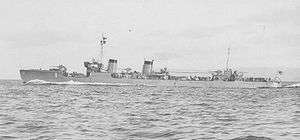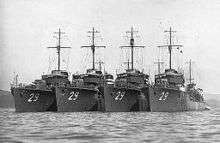Kamikaze-class destroyer (1922)
 Kamikaze underway on 23 December 1922. | |
| Class overview | |
|---|---|
| Name: | Kamikaze class |
| Builders: | |
| Operators: |
|
| Preceded by: | Wakatake class |
| Succeeded by: | Mutsuki class |
| In commission: | 1921–1947 |
| Planned: | 27 |
| Completed: | 9 |
| Cancelled: | 18 |
| Active: | 0 |
| Lost: | 7 + 1 (postwar) |
| Retired: | 1 |
| General characteristics | |
| Type: | Destroyer |
| Displacement: |
|
| Length: |
|
| Beam: | 9.1 m (30 ft) |
| Draught: | 2.9 m (9.5 ft) |
| Propulsion: |
|
| Speed: |
|
| Range: |
|
| Complement: | 154 |
| Armament: |
|
The Kamikaze-class destroyers (神風型駆逐艦 Kamikazegata kuchikukan) were a class of nine destroyers of the Imperial Japanese Navy.[1] Some authors consider the Nokaze, Kamikaze and Mutsuki classes to be extensions of the Minekaze-class destroyers, and the Kamikaze class is sometimes referred to as the "Kiyokaze class" to distinguish it from the earlier World War I-era destroyer class of the same name. Obsolete by the beginning of the Pacific War, the Kamikazes were relegated to mostly secondary roles. Most ultimately were lost to U.S. submarines.
Background
The Kamikaze-class vessels were an extension and improvement to the ongoing Minekaze-class program as part of the Eight-eight fleet Plan. They were ordered under the 1921-1922 fiscal budget. As with the Wakatake class, they were originally numbered, but were assigned individual names after 1928.[2]
Construction of the last two planned Kamikaze vessels was cancelled in conformance with the Washington Naval Treaty. Oite, Hayate, Asanagi and Yūnagi were called the Kamikaze-class late production model (or occasionally Oite class), as the powerplant and armaments were different.
Design

The Kamikaze-class ships were visually identical to the earlier Minekaze class, apart from slight detail changes in the bridge and the addition of an improved 120 mm/50 cal. main gun which was designed as a dual purpose mount.
The Kamikaze class was the first destroyer class in the Japanese Navy to be built with a bridge strengthened by steel plating. This gave the vessels a higher center of gravity, and to counteract this they were built with an increased displacement and a wider beam for better stability. Although they had slightly less speed >37.5 knots (69.5 km/h) they were considered satisfactory compared with the Minekaze class.[3]
Operational history
The Kamikaze-class vessels all saw combat during the Pacific War, with Hayate having the distinction of being the first Japanese destroyer to be lost in combat during that conflict. She was sunk during the Battle of Wake Island in December 1941.[4] By 1944 four Kamikaze-class vessels had been sunk by American submarines and a fifth was lost in an air raid on Truk. In 1945 a sixth ship was sunk by submarine action. Only Kamikaze and Harukaze survived the war, but Harukaze was in such poor condition when surrendered at Sasebo that she was soon scrapped. Kamikaze continued on as a repatriation ship after it was surrendered at Singapore, but grounded off Cape Omaezaki in June 1946 and was written off.[5]
Class members
| Kanji | Name | Builder | Laid down | Launched | Completed | Fate |
|---|---|---|---|---|---|---|
| 神風 | Kamikaze Destroyer No. 1 |
Mitsubishi-Nagasaki, Japan | 1921-12-15 | 1922-09-25 | 1922-12-19 | renamed Kamikaze 1928-08-01; demilitarized repatriation ship 1945-12-01; grounded Omaezaki 1946-06-07; stricken 1946-06-26 |
| 朝風 | Asakaze Destroyer No. 3 |
Mitsubishi-Nagasaki, Japan | 1922-02-16 | 1922-12-08 | 1923-06-16 | renamed Asakaze 1928-08-01; Torpedoed west of Luzon [16.06N, 119.44E] 1944-08-23; stricken 1944-10-10 |
| 春風 | Harukaze Destroyer No. 5 |
Maizuru Naval Arsenal, Japan | 1922-05-16 | 1922-12-18 | 1923-05-31 | renamed Harukaze 1928-08-01; surrendered to USN 1945-11-10; scrapped 1947 |
| 松風 | Matsukaze Destroyer No. 7 |
Maizuru Naval Arsenal, Japan | 1922-12-02 | 1923-10-30 | 1924-04-05 | renamed Matsukaze 1928-08-01; Torpedoed NW Chichijima [26.59N, 143.13E] 1944-06-09; stricken 1944-08-10 |
| 旗風 | Hatakaze Destroyer No. 9 |
Maizuru Naval Arsenal, Japan | 1923-07-03 | 1924-03-15 | 1924-08-30 | renamed Hatakaze 1928-08-01; Air attack off Takao [22.37N, 120.15E] 1945-01-15; stricken 1945-03-10 |
| 追風 | Oite Destroyer No. 11 |
Uraga Dock Company, Japan | 1923-03-16 | 1924-11-27 | 1925-10-30 | renamed Oite 1928-08-01; Air attack at Truk [07.40N, 151.45E] 1944-02-18; stricken 1944-03-11 |
| 疾風 | Hayate Destroyer No. 13 |
Ishikawajima Shipyards, Japan | 1922-11-11 | 1925-03-24 | 1925-11-21 | renamed Hayate 1928-08-01; combat loss Battle of Wake Island [19.16N, 166.37E] 1941-12-11; stricken 1942-01-10 |
| 朝凪 | Asanagi Destroyer No. 15 |
Fujinagata Shipyards, Japan | 1923-03-05 | 1924-04-21 | 1925-12-29 | renamed Asanagi 1928-08-01; torpedoed W of Ogasawara [28.20N, 138.57E] 1944-05-22; stricken 1944-07-10 |
| 夕凪 | Yūnagi Destroyer No. 17 |
Sasebo Naval Arsenal, Japan | 1923-09-17 | 1924-04-23 | 1925-05-24 | renamed Yūnagi 1928-08-01; torpedoed NW of Luzon [18.46N, 120.46E] 1944-08-25; struck 1944-10-10 |
Naming history
The IJN originally planned that the Kamikaze-class ships should have names, but upon completion they were given numbers due to the projected large number of warships the IJN expected to build through the Eight-eight fleet plan. This proved to be extremely unpopular with the crews and was a constant source of confusion in communications. In August 1928, names were assigned, but not the original names that were planned.
| Planned name and transliteration | Name as completed | Renamed 24 April 1924 | Renamed 1 August 1928 |
| Kiyokaze (清風) Pure Wind or Soyokaze (微風) Breeze |
Dai-1 Kuchikukan (第一駆逐艦), 1st Destroyer |
Dai-1-Gō Kuchikukan (第一号駆逐艦), No.1 Destroyer |
Kamikaze (神風), God Wind |
| Karukaze (軽風), Light Wind |
Dai-3 Kuchikukan (第三駆逐艦), 3rd Destroyer |
Dai-3-Gō Kuchikukan (第三号駆逐艦), No.3 Destroyer |
Asakaze (朝風), Morning wind |
| Makaze (真風) True Wind | Dai-5 Kuchikukan (第五駆逐艦), 5th Destroyer |
Dai-5-Gō Kuchikukan (第五号駆逐艦), No.5 Destroyer |
Harukaze (春風), Spring Wind |
| Ōkaze (大風), Great Wind |
|||
| Tsumujikaze (旋風), Whirlwind |
|||
| Dai-7 Kuchikukan (第七駆逐艦), 7th Destroyer |
Dai-7-Gō Kuchikukan (第七号駆逐艦), No.7 Destroyer |
Matsukaze (松風), Pine Wind | |
| Dai-9 Kuchikukan (第九駆逐艦), 9th Destroyer |
Dai-9-Gō Kuchikukan (第九号駆逐艦), No.9 Destroyer |
Hatakaze (旗風), Flag Wind | |
| Dai-11-Gō Kuchikukan (第十一号駆逐艦), No.11 Destroyer |
Oite (追風), Tail Wind | ||
| Dai-13-Gō Kuchikukan (第十三号駆逐艦), No.13 Destroyer |
Hayate (疾風), Gale | ||
| Dai-15-Gō Kuchikukan (第十五号駆逐艦), No.15 Destroyer |
Asanagi (朝凪), Morning Calm | ||
| Dai-17-Gō Kuchikukan (第十七号駆逐艦), No.17 Destroyer |
Yūnagi (夕凪), Evening Calm | ||
Notes
References
Books
- Brown, David (1990). Warship Losses of World War Two. Naval Institute Press. ISBN 1-55750-914-X.
- Evans, David (1979). Kaigun: Strategy, Tactics, and Technology in the Imperial Japanese Navy, 1887-1941. US Naval Institute Press. ISBN 0-87021-192-7.
- Hara, Tameichi (1978). Japanese Destroyer Captain. Ballantyne Books, New York. ISBN 0-345-27894-1.
- Howarth, Stephen (1983). The Fighting Ships of the Rising Sun: The Drama of the Imperial Japanese Navy, 1895-1945. Atheneum. ISBN 0-689-11402-8.
- Jentsura, Hansgeorg (1976). Warships of the Imperial Japanese Navy, 1869-1945. US Naval Institute Press. ISBN 0-87021-893-X.
- Watts, Anthony J (1967). Japanese Warships of World War II. Doubleday. ASIN B000KEV3J8.
- Whitley, M J (2000). Destroyers of World War Two: An International Encyclopedia. London: Arms and Armour Press. ISBN 1-85409-521-8.
External links
- Nishida, Hiroshi. "Materials of IJN: Kamikaze class destroyer". Imperial Japanese Navy.
- Globalsecurity.org. "IJN Kiyokaze class destroyers".
- Jones, Daniel H. (2003). "IJN Minekaze, Kamikaze and Mutsuki class Destroyers". Ship Modeler's Mailing List (SMML).
- Japanese Destroyers: Tabular Movement Records (TROMs)
- Kamikaze Class, Japanese Destroyers
| Wikimedia Commons has media related to Kamikaze class destroyers (1922). |